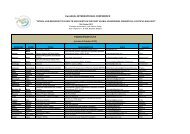Concept Note - EuroNGOs
Concept Note - EuroNGOs
Concept Note - EuroNGOs
Create successful ePaper yourself
Turn your PDF publications into a flip-book with our unique Google optimized e-Paper software.
Objective of Mapping SRHR Civil Society Organizations in Kenya<br />
The purpose of mapping civil society organizations working in the reproductive health sub-sector is to<br />
provide stakeholders in the health sector including the Development Partners with an overview of<br />
main SRHR CSOs in Kenya. This exercise will provide a deeper understanding of their operations as<br />
well as their capacity to engage in reproductive health advocacy in an environment which is only partially<br />
supportive of SRHR. It will also help increase knowledge on the challenges that they face, in order to<br />
develop effective ways of supporting these organizations to undertake SRHR advocacy, monitor the<br />
progress of implementation of SRHR policies and build the capacity of communities to demand for<br />
adequate and quality SRHR services in health facilities. Additionally, it will enable the organizations to<br />
identify key allies with the potential to form strategic alliances for working towards improving the<br />
situation of SRHR in the country. It will also help them to understand the different initiatives that are<br />
taking place in diverse regions and how to build on them, in order to expand the interventions in the RH<br />
sub-sector without duplicating efforts in similar regions and targeting the same population.<br />
The activity is both timely and useful because it coincides with the efforts that are being made towards<br />
operationalizing the Constitution, 2010, development and implementation of multiple policies meant to<br />
improve the situation of SRHR in Kenya. As these efforts unfold, it is important to identify and<br />
consolidate the work of civil society organizations to contribute towards implementation of the new laws<br />
and policies. In addition, the Constitution is set to introduce a new set of structures and modify existing<br />
ones to ostensibly serve people in a more effective and transparent manner. The civil society remains a<br />
strategic actor in all these efforts and has a significant role, to complement the government’s work of<br />
strengthening the capacity of communities to take an active role in service delivery and monitoring the<br />
work of government’s institutions.<br />
Methodology, risks and assumptions and dissemination<br />
Given the time and resource limitations, the exercise will endevour to gather and analyze primary data<br />
from both urban and rural-based SRHR CSOs and networks using questionnaires and semi-structured<br />
interviews. Secondary data will be gathered from existing databases that are managed by the government<br />
and non-state actors. Some of the risks anticipated in this exercise are lack of access to relevant<br />
information and databases, lack of response (or low response rate) by the CSOs and misrepresentation of<br />
facts. The success of this exercise is therefore hinged on the assumption that information will easily be<br />
accessed and availed, the government and CSOs contacted will be responsive and they will provide<br />
accurate information.<br />
The data collected through questionnaires and semi-structured interviews will cover the following areas:<br />
name of the organization, duration of operation, target population, number of staff and annual turnover.<br />
Limited information regarding their programmes will also be gathered. This will be grouped into two,<br />
advocacy and other programmatic areas such as service delivery and training.<br />
The data collected will be analyzed and used to prepare a report describing the operations of SRHR civil<br />
society organizations, areas of focus and institutional capacities. The report will be widely disseminated<br />
among donors and if possible officially presented to the DPHK working group. In addition, it will be<br />
shared with CSOs within and outside the SRHR sub-sector as well as other key stakeholders including the<br />
Ministry of Health and other government institutions.<br />
2





